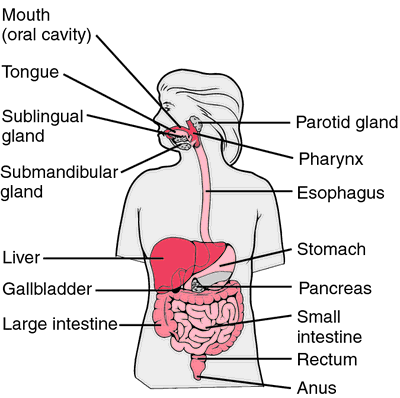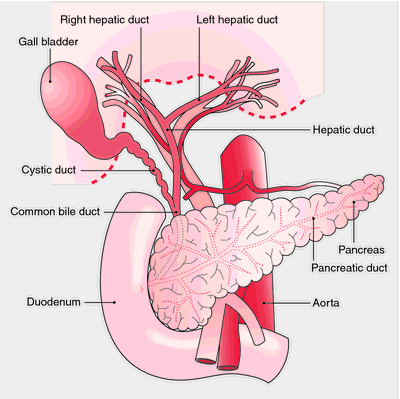alimentary
[al″ĭ-men´tah-re]pertaining to or caused by food or nutritive material.
alimentary canal (alimentary tract) the portion of the digestive system consisting of the organs making up the route taken by food as it passes through the body from mouth to anus; this includes the esophagus, stomach, and small and large intestines. ( and Plate 9.) Called also digestive tract.

Organs of the alimentary canal. From Applegate, 2000.
tract
[trakt]a longitudinal assemblage of tissues or organs, especially a number of anatomic structures arranged in series and serving a common function, such as the gastrointestinal or urinary tract; also used in reference to a bundle (or fasciculus) of nerve fibers having a common origin, function, and termination within the central nervous system.
alimentary tract alimentary canal.
biliary tract the organs, ducts, and other structures that participate in secretion (the liver), storage (the gallbladder), and delivery (hepatic and bile ducts) of bile into the duodenum. See illustration.

Anatomy of the gallbladder and biliary tract. From Aspinall and Taylor-Robinson, 2002.
corticospinal t's two groups of nerve fibers (the anterior and lateral corticospinal tracts) that originate in the cerebral cortex and run through the spinal cord.
digestive tract alimentary canal.
dorsolateral tract a group of nerve fibers in the lateral funiculus of the spinal cord dorsal to the posterior column.
extrapyramidal tract extrapyramidal system.
gastrointestinal tract the stomach and intestine in continuity; see also digestive system.
iliotibial tract a thickened longitudinal band of fascia lata extending from the tensor muscle downward to the lateral condyle of the tibia.
intestinal tract see intestinal tract.
optic tract the nerve tract proceeding backward from the optic chiasm, around the cerebral peduncle, and dividing into a lateral and medial root, which end in the superior colliculus and lateral geniculate body, respectively.
pyramidal t's collections of motor nerve fibers arising in the brain and passing down through the spinal cord to motor cells in the anterior horns.
respiratory tract respiratory system.
urinary tract the organs and passageways concerned in the production and excretion of urine from the kidneys to the urinary meatus; see also urinary system.
uveal tract the vascular tunic of the eye, comprising the choroid, ciliary body, and iris.
Miller-Keane Encyclopedia and Dictionary of Medicine, Nursing, and Allied Health, Seventh Edition. © 2003 by Saunders, an imprint of Elsevier, Inc. All rights reserved.
di·ges·tive tract
the passage leading from the mouth to the anus through the pharynx, esophagus, stomach, and intestine.
Farlex Partner Medical Dictionary © Farlex 2012
di·ges·tive tract
(di-jes'tiv trakt)The passage leading from the mouth to the anus through the pharynx, esophagus, stomach, and intestine.
Synonym(s): alimentary canal, alimentary tract.
Synonym(s): alimentary canal, alimentary tract.
Medical Dictionary for the Health Professions and Nursing © Farlex 2012
di·ges·tive tract
(di-jes'tiv trakt)Passage from mouth to anus through pharynx, esophagus, stomach, and intestine.
Synonym(s): alimentary tract.
Synonym(s): alimentary tract.
Medical Dictionary for the Dental Professions © Farlex 2012